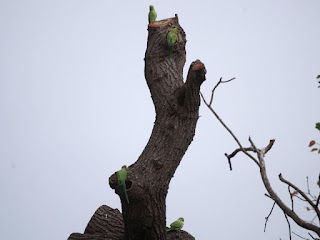A small gang of Red-Crested Pochards often visits the Serpentine island.
They have no dealings with the drake in the Italian Garden with his Mallard mate. Perhaps they think he has married beneath his station. Here he is with the pair of Gadwalls who have also taken up residence in the fountain pool.
The Mallard drakes are all looking splendid in their new breeding plumage. Their fine feathers need careful maintenance.
The Serpentine shore at the Lido is always a busy place. The terrace of the restaurant ensures that there are plenty of food scraps, and maybe also someone who wants to feed the Mute Swans.
A Black-Headed Gull ate a chestnut with the shell on. Evidently its digestive system can cope with this challenging snack.
On a more pleasant day than yesterday there were enough people on the terrace of the Dell restaurant to attract a small group of Starlings, which waited expectantly in the hawthorn tree.
A Carrion Crow stood on the weatherbeaten head of a water nymph in the Italian Garden. When the garden was renovated a few years ago she got a new left arm to replace the one that had broken off, but there was nothing they could do to save her face short of replacing the entire statue.
A Jay at the bridge raised its crest.
Rose-Ringed Parakeets have completely taken over a dead tree near the Albert Memorial which used to be the home of a Great Spotted Woodpecker. Although there are still many suitable places for native hole-dwelling birds in the thousands of trees of the park, there is no doubt that the parakeets are putting unwelcome pressure on them.
A Robin looked out warily from a post in the Rose Garden. They are much shyer here than in Kensington Gardens where people feed them.
A Wren hopped around in dead leaves beside the Long Water.
A Blue Tit perched among holly berries near the bridge.
There is a large and widening expanse of Sulphur Tuft mushrooms on the patch of wood chips north of the Albert Memorial. They are pretty, but said to be bitter tasting and fairly poisonous.












A bit late: the brownish mushrooms in Monday post are Gymnopus dryophilus, the Russet Toughshank.
ReplyDeleteThe grey ones, the inkcaps, rather then Coprinellus disseminatus, are more likely to be Hare'sfoot Inkcap Coprinopsis lagopus
Mario
Thanks very much. Will amend Monday's blog.
DeleteAnybody here who likes a bit of art might want to have a look at The Natural Eye 2019 exhibit by the Society of Wildlife Artists at the Mall Galleries , until 3rd November. Plenty of birds! Right opposite St James' park, so you can go and see some real birds afterwards.
ReplyDeleteLovely video portrait One Minute at the Lido.
Thank you, will try to fit it in.
DeleteWould cameras be allowed? Would love to see some images.
DeleteIt's wonderful to see how many species gather to make the most of food scraps at the Lido. We even got to see some Coot yoga too!
I'll be sorry not to see the charming Call Duck around any longer, but thankfully she is going to have a great life at the Swan Sanctuary accompanied by many friends. A happy ending.
Mallard female ducks are certainly drab creatures, but I imagine that they are feistier than their female Red Crested Pochard counterparts. What she may lack in beauty she will make up for with spirit.
The members of the Society of Wildlife Artists have a gallery which you can see here.
DeleteI've seen Red-Crested Pochards of both sexes chasing Mallards. They are quite aggressive.
and this is the mall galleries's website: https://www.mallgalleries.org.uk
DeleteWow, thank you both!
DeleteThat might not be a nymph, according to an American authority on corvids:
ReplyDeleteNot the least obeisance made he; not a minute stopped or stayed he;
But, with mien of lord or lady, perched above ...
Perched upon a bust of Pallas just above ...
Perched, and sat, and nothing more.
Poe notwithstanding, they are the nymphs of the Westbourne river, now disloyally dispensing water from a borehole because the smelly river was rerouted round the north side of the park in 1860. The river god himself is on the keystone of the central arch of the loggia, looking miserable because his river has been taken away and his nymphs have deserted him. At night the nymphs retire to the nymphaeum at the northwest corner of the Italian Garden, which has a cosy little house built into the back of it.
Delete